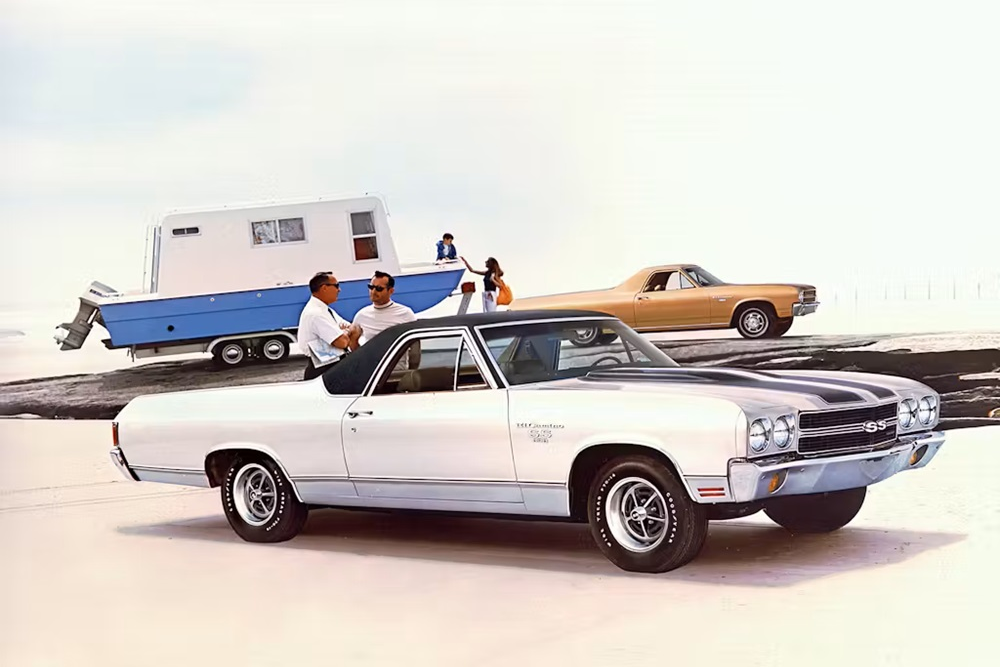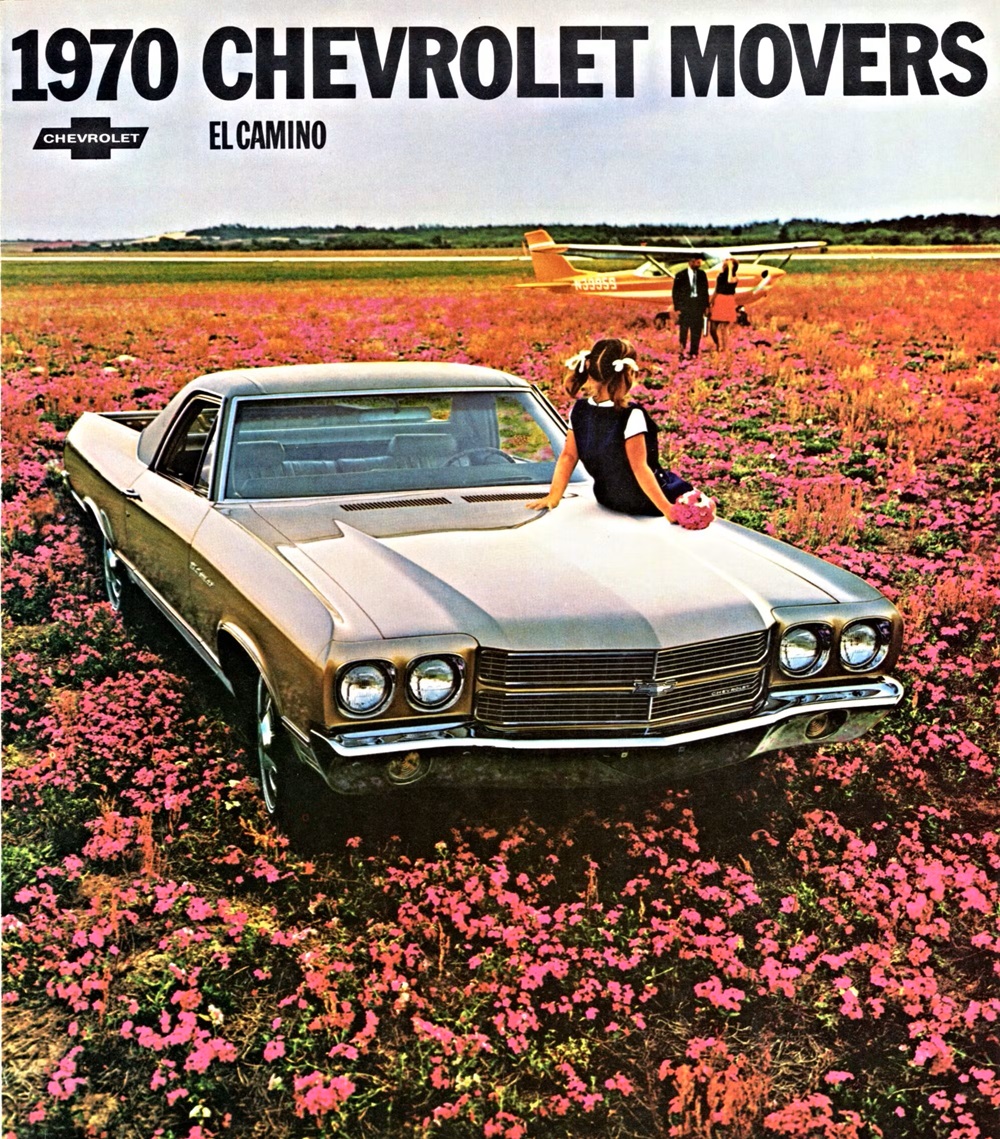Automotive landscape may be populated by all sorts of half-this, half-that vehicles (coupe-SUVs, anyone?), but you can’t walk into any new-car dealer in America today and find something quite like like the El Camino.

Debuting in 1959 as a modified two-row station wagon, this car-based pickup grew up into a Chevlle-based “ute” in 1965 and was built in several generations until as late as 1987, with sales totaling nearly one million. Thanks to that long production range, you can find an “ElCo” of just about any era that suits you, from the classy tailfinned originals to the mullet-and-mustache conclusion forced out of production when pickups began to replace cars as daily drivers.

Blink, and you might miss the first generation of El Camino, introduced by Chevrolet for 1959. It was the General’s response to Ford, who had announced the Ranchero, based on its full-size car platform, for 1957. Though later generations of the El Camino would eventually outlast and outsell the Ford, the first El Camino was hardly the hit that Chevy had hoped, so the ute disappeared after just two years on the market. Three years after its competition disappeared, the Ranchero was still selling well, so Chevrolet went back to the drawing board and designed another El Camino, this time on the Chevelle platform.
The 1964 El Camino benefited from all the work Chevy had put into developing the ’64 Chevelle, including that car’s engine choices and wide-ranging trim levels. For the third generation introduced for 1968, Chevrolet infused the El Camino with the full range of Chevelle goodness, including a Super Sport (SS) variant. Today, those SS models are far and away the most expensive examples of the desirable third generation (’68 and ’69 models with the L78, L89, or LS6 exceed $100K), but if you’re on a budget, don’t be discouraged: You can find a clean, V-8 ElCo for $30K or less.

The third-gen El Camino was the most muscular one yet, both aesthetically and mechanically, thanks to its Chevelle DNA. From the A-pillar forward, it looked identical to its handsome sibling, with four headlights beneath a rakish chrome brow. The changes started at the broad B-pillar, which flowed downward to frame the sloping sides of a 79×39.5-inch bed with a bottom-hinged tailgate. And yes, the ute could tow!
Engines increased in number and output when the 1968 car arrived. Displacement of the base V-8 (on the Standard trim) grew from 283 to 307 cubic inches, and output was 5 hp higher (200). The next rung up the powertrain ladder remained a 327-cubic-inch engine, but there was an additional tune on offer, for a total of three: 275, 325, and 375 hp, all available on the Custom model along with chrome molding for the lower body panels.
The SS-spec engines in 1968 included the “Turbo-Jet” L35, which displaced 396 cubic inches, and the L34, which Chevy called a 396 but whose displacement was actually 402 cubic inches. Those mills made 325 and 350 hp, respectively. The magic years, for those who want maximum performance in their third-gen El Camino, are 1969 and 1970. In ’69, Chevrolet added two more SS-spec engines, the 396-cubic-inch L78 and the aluminum-head L89, both rated for 375 hp. The legendary 454-cubic-inch V-8 arrived for 1970 in two states of tune: LS5, with 360 hp, and the holy-grail LS6, with 450. The LS5 was available in the El Camino for ’71 and ’72 as well, but after 1970 the LS6 was gone from the lineup.
GM tweaked the styling of each model year from 1968 to 1972, though the most obvious changes occurred every other year and are most easily seen at the front. In 1970, the chrome “brow” disappeared, replaced by front fenders that plunged nearly straight down, rather than back, and flanked a larger, rectangular grille. In 1971, Chevy replaced the pairs of headlights with single lenses, and integrated two stacked turn signals into the forward ends of the front fenders. Those stacked elements blended into one for 1972, the final year of the third generation.

There’s a clearly defined hierarchy of values when it comes to the El Camino, and it should be familiar to muscle car fans—the rarer and more powerful the engine, the higher the price. The king of the ’68–72 El Caminos, ranked by value, is the SS 396 from 1969: One in #2 (excellent) condition is $128,000, and a concours-quality example breathes even rarer air: $174,000. Interestingly, the El Camino with the largest-displacement and most powerful engine, an LS6-powered 1970 car, costs less: $105,000 in #2 condition.
The good news for ute enthusiasts on a budget is that El Camino values decrease rapidly as the engines become slightly tamer and the production numbers more plentiful. You don’t even have to give up an SS badge: Set aside the 454, and the two highest-spec engines for ’69 (the L78 and the L89), and you can get an SS in #2 condition between $39,200 and $41,800. If you simply want an El Camino, and don’t have to have an SS, your options become even more plentiful and affordable: With the exception of the 1970 year, 350- and 375-powered cars fall below $40K. Find a lovingly maintained driver with few dings, and you’re well under $30K.
El Caminos are sometimes—but not always—cheaper than their better-known brethren, Chevelles. The top end of the Chevelle market is far above that of the El Camino, even after setting aside the COPO and Yenko cars: a 1970 LS6 coupe, for instance, is $172,000 in #2 condition; a convertible, $369,000. However, at $128K in #2 condition, the top-dog El Camino (’69 L89), is more expensive than the comparable Chevelle. Step a little further down the ladder, and a 454-equipped El Camino from 1970 is $58,600, while an LS5-powered Chevelle of the same vintage is $86,400. Compare prices for 350-powered Chevelles and El Caminos, though, the Chevelle is sometimes the better bargain. In short, any comparison between the two markets must leave room for nuance.
Though values for the ’68–72 El Camino are up 25 percent over the last five years, much of that increase is explained by the heating we saw across the collector car market during and immediately after the pandemic. Pre-pandemic, values were growing, but very gradually. Values for third-gen El Caminos are quite stable, as a rule: Their last significant fluctuation was in 2009 and mirrored another broader trend–the dramatic correction of the muscle car market.
The ’68–72 cars are most often purchased by those who remember them as a weird, awesome highlight of the muscle car’s golden era. This vintage of El Camino appeals disproportionately to boomers, who represent 32 percent of the collector car market as a whole but make up nearly half of insurance quotes we receive for this generation ElCo. Gen X falls in second place, with 26 percent of third-gen El Camino quotes (but 31 percent of the overall market).
A delightfully weird offshoot of Chevrolet’s most horsepower-happy years, the third-gen El Camino is a classic for good reason. The wide spread of values covers a broad array of buyers, from discerning collectors of American muscle who want a perfectly preserved LS6-powered example to enthusiasts who want an affordable, cool collectible that might even make the weekend trip to Home Depot a little easier.
Report by Grace Houghton










